If you’ve spent much time on our site here at KGR (and of course you have…right?!), you will have most likely come across our reviews of various Epiphone Les Paul models (such as the Studio and the Custom Pro). And you’ll know that we think they are mighty fine guitars in their own right.
While we really do believe that to be true, there’s no denying the fact that Epiphone Les Paul guitars are simply lower-cost versions of their much higher-priced Gibson counterparts. But were you aware that – with a few fairly easy Les Paul mods you can do on your own – you can get that Epi to sound and play nearly as well as a true Gibson (even more than they already do right off the rack)?
We may be stating the obvious here, but to get the price down to that ‘sweet spot’, Epiphone did have to make some compromises on part and component choices.
So, what is our recommendation?
Take a few minutes and check out our Ultimate Epiphone Les Paul Upgrade Guide below. Whether you follow all of our suggestions or only a few of them, you’re sure to reap the benefits, turning that Epi into something much more than it was that day you pulled it off the rack.
By the way, if you’re just here for the pickups, check out our dedicated rundown of the Best Les Paul Pickups.
Contents
Les Paul Mods: Where to Start and What to Upgrade First
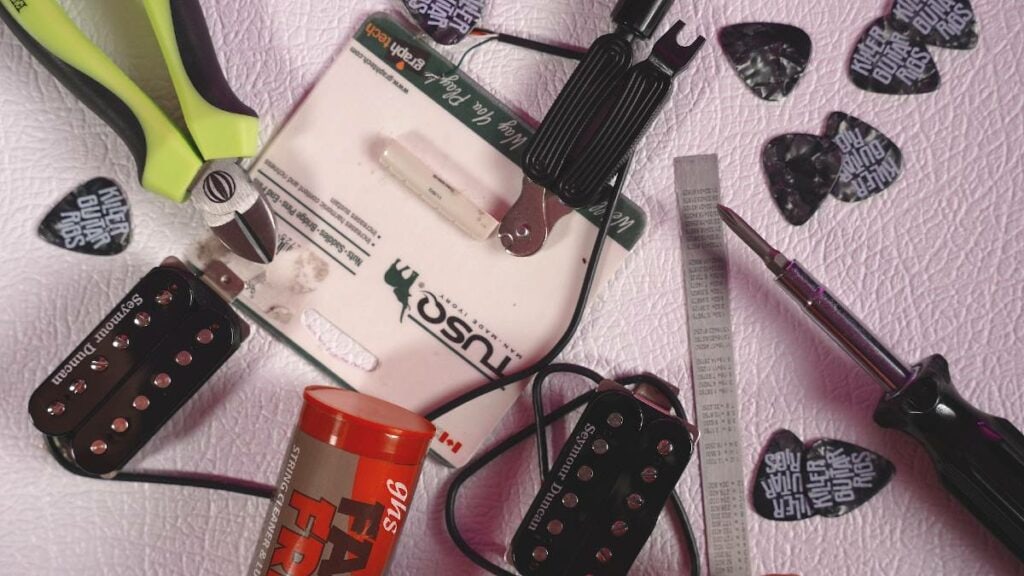
The most common question from those with budget guitars is… What’s the most crucial upgrade to start with? Most musicians will tell you to upgrade parts that affect the tone most, while luthiers and seasoned players highly recommend playability.
The answer is to give your Epiphone Les Paul a good playthrough for a week or more and pay close attention to your instincts. Listen to what feels off and what bothers you the most. The guitar will let you know what’s the most ideal mod to do first and what upgrades are best left for later.
If the sound is your focus, head to the pickups. If you want your guitar to stay in tune and feel better, start with the nut and then consider the tuning keys.
Whatever you do, only carry out the mods that the guitar actually needs, not just what you heard online.
The following below is what I consider the most ideal way to mod or upgrade your Epiphone Les Paul. You can work your way back and forth on the list depending on what you currently need and prioritize.
Pickups
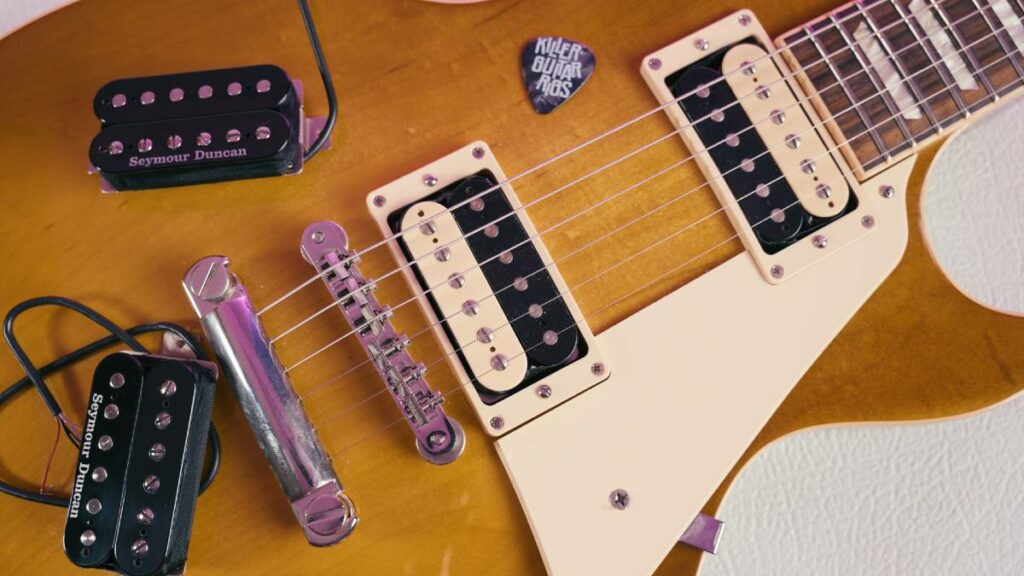
Difficulty: 3/5
Cost: 5/5
Necessity: 5/5
This is the most impactful mod to the sound of your Les Paul as well as the most personal.
Most guitar reviews focus on the pickups alone and for good reason. Pickups are the most important element of your guitar’s sound. They are the heart, voice, and soul that most people will hear and they’re responsible for reflecting your playing. A beautiful-looking Les Paul is only as good as its era-defining sonic qualities.
Changing the Pickups
If you decide to upgrade (and you find adjusting the height doesn’t get you there), we recommend putting most of your budget into a great set of pickups. They make almost 80% of your guitar sound and sound is what really defines the Les Paul and player behind it. A great set of humbuckers will make your Epiphone Les Paul sound indistinguishable from its more expensive cousin.
When it comes to choosing pickups, the world is your oyster.
If you love classic Les Paul tones, PAF-inspired pickups are your best bet. Vintage-sounding humbuckers usually have alnico magnets on them. Seymour Duncan has a lot of vintage-voiced humbuckers like the ’59 Model, Pearly Gates, and Antiquities to name a few. Dimarzio also has a lot of vintage output pickups in their lineup, like the EJ humbuckers, PAF 59s, PAF Masters, and the PAF Anniversary. Bare Knuckle’s Boot Camp Old Guard humbuckers and Suhr’s Thornbucker and Thornbucker Plus are also classic-inspired humbuckers worth considering.
If you opt to go for a more modern sound, pickups with ceramic magnets would be ideal. These tend to have higher output, to be brighter, and to be very articulate. Fishman Fluence Moderns, Seymour Duncan’s Alpha and Omega, or a set of EMGs can give you a wide range of sounds that cut well through a mix. You also can’t go wrong with a Seymour Duncan JB and Jazz set – a staple of higher gain 90s bands.
Heading toward an unconventional route has always been fun and exciting. Luckily, we live in an era where the choices are wide and the possibilities endless. Easy-to-mount humbucker-sized P90s and FilterTrons are widely available if you want to go for a unique sound. Choosing these kinds of pickups will definitely make your Les Paul stand out from the rest.
Ditch the Pickup Covers
The Les Paul humbuckers at this price range struggle with pickups that sound muddy, lacking in clarity and sensitivity (though the newer Custom models are an improvement over say the 100). Many players get a quick and cheap improvement by removing the pickup covers on their humbuckers, making it a bit of an insider Les Paul mod for those wanting a fast change.
The pickup covers are thought to roll off the top-end characteristics of a pickup. Players discovered that pickups with exposed pole pieces tend to have more clarity and are more sensitive to your picking attack.
Rock legends like Slash use humbuckers without pickup covers in order to cut through the mix more effectively with improved top-end presence.
On the other hand, Jimmy Page’s “Number 1” 1959 Gibson Les Paul has a bare bridge pickup and a covered neck pickup. This allows the Led Zeppelin legend to have full access to the bright grit of the bridge pickup and the warm, dark tones of the neck humbucker.
With this simple DIY mod, you may discover sweet spots of the stock pickups that well-suit your playing. This is something to consider before spending for a new set of humbucking pickups.
Nut
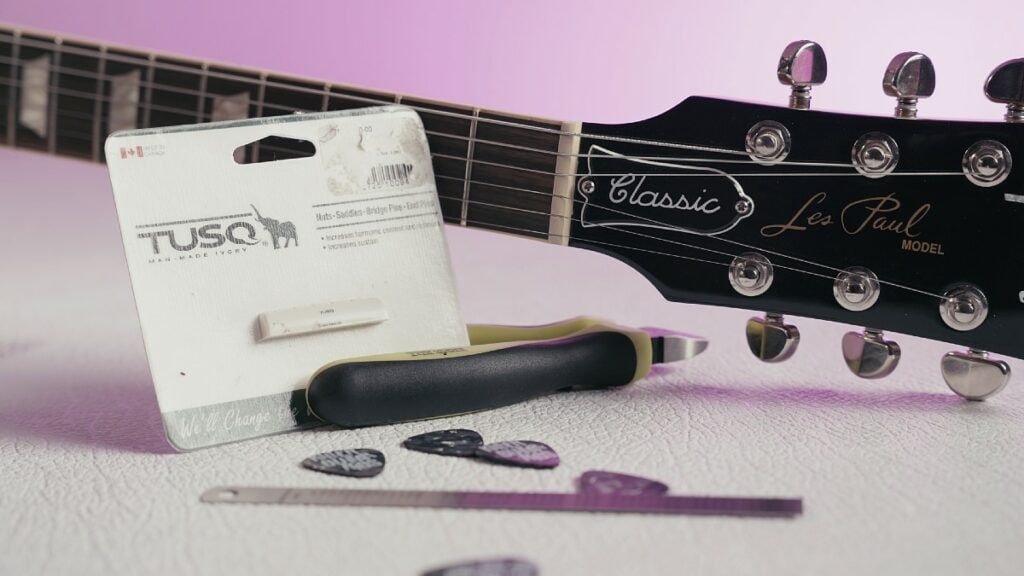
Difficulty: 3/5
Cost: 1/5
Necessity: 5/5
The problem with most budget guitars is that they stray out of tune so easily, mainly because of the way the nut is cut. While a good setup can help, a lot of cheap nuts are never going to sound right. This often hinders a player from practicing more or even picking up the instrument.
The nut is often overlooked by many musicians, but it is probably the most crucial upgrade to get the best performance out of your Epiphone Les Paul. Always remember that the nut is one of the two critical anchor points that transfer vibrations from the strings to the body. Having a great-quality nut will not only improve the tone and sustain of your open notes, but also the overall playability. One way to identify a good guitar is by looking at how well-cut and perfectly fitted the nut is.
Most musicians say that a bone nut is probably your best go-to since it gives a more “organic” sound, but bone nuts tend to be expensive and inconsistent. These days, graphite or synthetic bone nuts work great at a price that won’t break the bank. You can read more in our guide to choosing a Bone Nut vs TUSQ.
This mod is best done with a luthier or guitar tech since it requires precision to get it right and perfect. Luthiers have the necessary tools needed to cut, file, and fit the nut. Some guitars may also need wood filing to better fit a nut. A luthier can specifically shape the nut suited for your setup preferences and the string gauge you use.
Epiphone Les Pauls usually have a 1.68” nut slot, and GraphTech Labs has a wide range of material choices from graphite to synthetic bone. Their well-known TUSQ nuts have been used by boutique and high-end brands such as Suhr, Anderson, Knaggs, and many more – you can pick up their Epiphone slotted TUSQ nuts (in white or black) or their Gibson slotted TUSQ nut for about $15 a piece.
Les Paul Electronics Mods
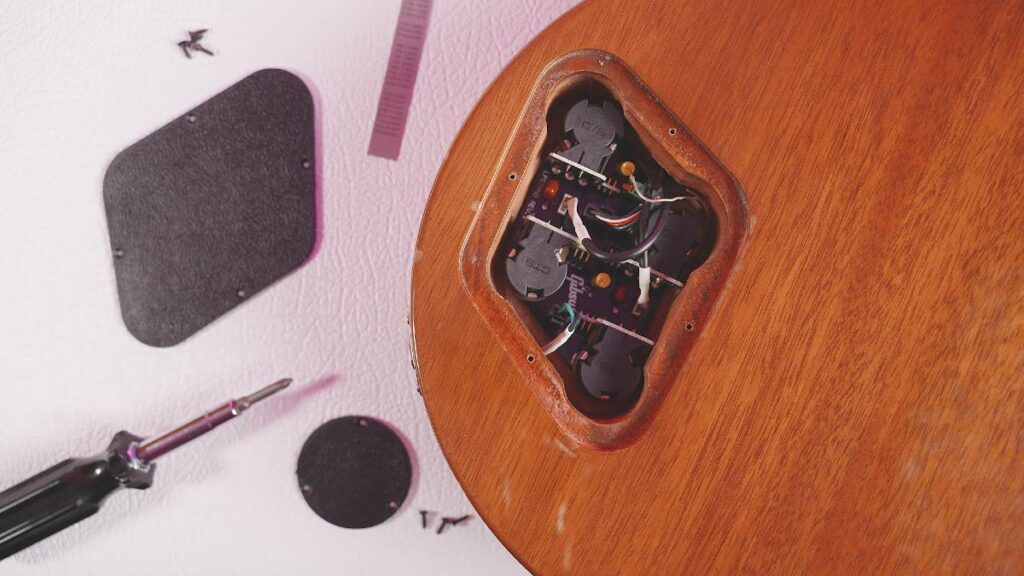
Difficulty: 1/5
Cost: 5/5
Necessity: 4/5
Almost every guitar player rushes to upgrade the pickups first. It is arguably true that the pickups make up 80% of the guitar’s tone and that getting great-sounding pickups can take your tone from basement-only to stage-worthy.
That being said, it is best to first upgrade the factors that help shape the sound of the pickups, and this is where upgrading your Les Paul electronics will pay off in spades.
Switches or Pickup Selectors
Switches or pickup selectors play a vital role in getting the widest tonal variety from your guitar.
Switching between pickups on a budget guitar can be bothersome. We often hear loud pops that would cut through the mix when we’re playing. Selectors at this budget are also prone to failure, and they have a high chance of breaking onstage.
A good toggle like Switchcraft’s 3 Way Les Paul Toggle will help you switch smoothly between pickups and will stand up to continued rough use.
Output Jack
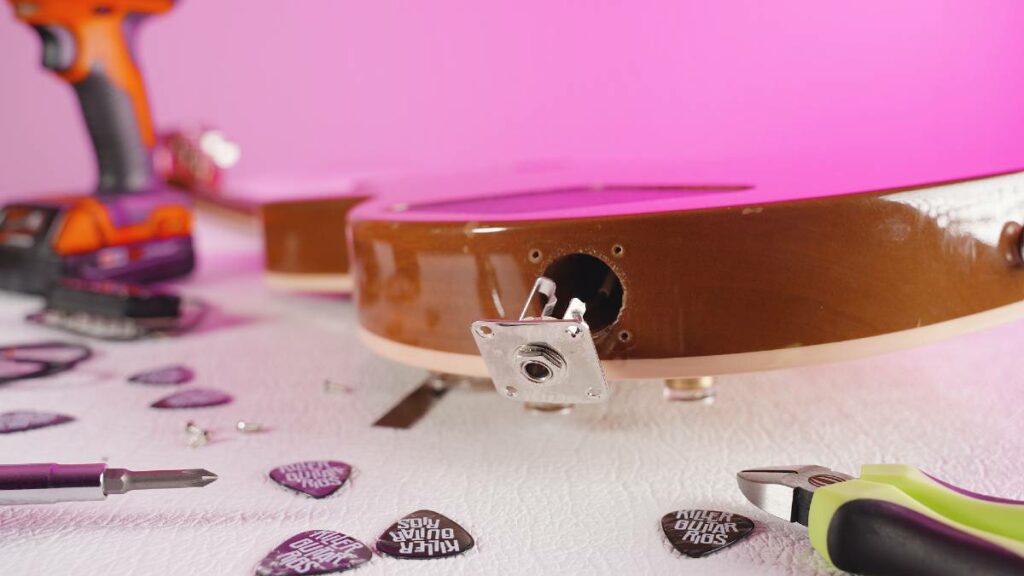
The output jack is also an underrated upgrade. Almost every budget guitar has a faulty output jack. This can lead to dropouts and buzzing in your signal. A quality output jack and plate will help you get rid of those problems and will make your performances worry-free. Again, Switchcraft is your go to here, with their standard long bushing 1/4″ mono 2-conductor jack running at only $7.
Potentiometers and Capacitors
Next, we head to the volume pots, tone pots, and capacitors. These affect the sound of the pickups the most.
Cheap potentiometers are known for their drastic taper, which can make it difficult to dial into the sweet spots of your pickups. A good set of 500k pots from CTS or Bourns will greatly improve the sound range of your pickups.
Capacitors also contribute to the tonal quality of the pickups and it’s best to match them with the tone pots and pickups you use.
Most Les Pauls use capacitors with values 0.022uF. It’s nice to experiment with different values to get the tones you want.
If your pickups sound too bright, you might want to consider 0.047uF capacitors; If too dark, 0.022uF caps are your best bet.
If you plan on installing coil-split switches on your guitar, 0.033uF caps work well for both single-coil and humbucker sounds.
Sprague orange drop capacitors are high-quality and easy to get hold of.
Wiring Mods
If you’re confident enough to solder, you might want to try out the ‘50s-style wiring mod. It is one of the simplest and cheapest mods you can do to your Epiphone Les Paul.
Gibson hooked things up this way until 1962.
By connecting the tone control to the middle or output tag of the volume rather than the outer or input tag, the volume and tone controls become more interactive, which allows you to turn down your volume without muddying up the sound.
Addtionally, you can save yourself some of the headache by purchasing a full wiring set – Emerson makes our favorite 50s style kit with handwired CTS 500k Pots, Bumblebee Paper in Oil Capacitors and a switchcraft jack, giving you a full solder in set that’ll give you the mod plus all premium components.
920D Custom make a number of premium wiring harnesses, such as this Custom Les Paul Pre-Wired Harness, featuring long shaft pots, Orange Drop caps, Gavitt wiring, and Pure Tone jacks. They also have a Jimmy Page push-pull version we rock on one of our LPs at the KGR studio for when we want a variety of tones.
Tuners
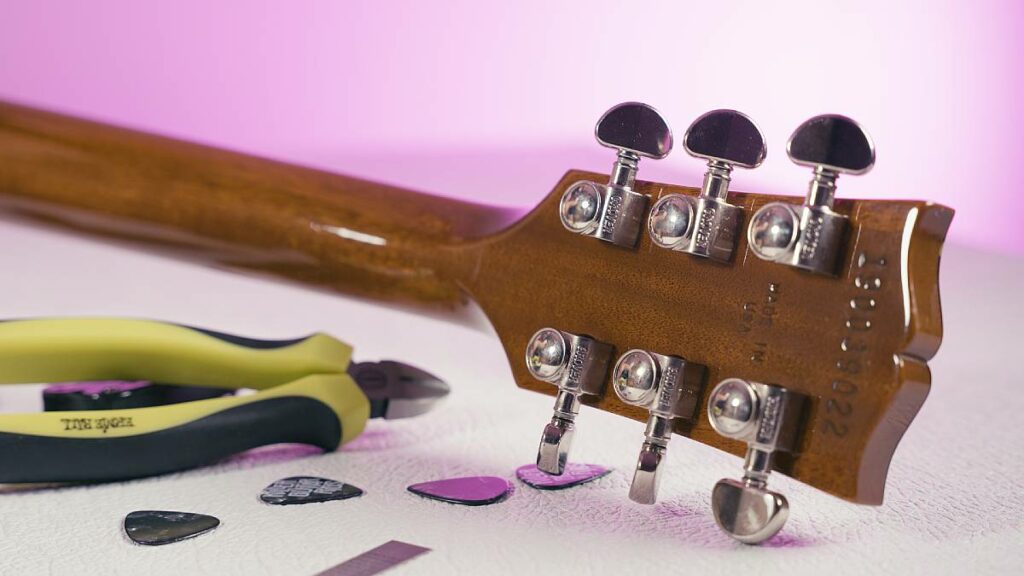
Difficulty: 4/5
Cost: 3/5
Necessity: 3/5
The stock Epiphone die-cast tuners work surprisingly well, but it’s always worth upgrading if you have the budget, making this one of the most popular Les Paul mods.
Upgrading to new tuning machines can be confusing with all the different kinds of tuners available. Unless you are changing to tuning machines with the exact same specifications as the stock ones, there will be necessary modifications, such as widening the peg holes or even drilling additional mounting screws, in order for them to fit nicely.
Most Les Pauls in the Epiphone range have peg holes that vary from 3/8″ to 10mm while more of the vintage-inspired Epiphone Les Pauls have 1/4″ to 11/32″. A good rule of thumb is to replace your tuners with the same kind of tuning machines.
Like pickups, there are a variety of tuning machines to choose from. Gotoh make a wide variety of tuners, from the chrome 18:1 Rotomatics to gold Rotogrips. The most ideal upgrade would be a set of locking tuners. Grover, Hipshot, Gotoh, and Graph Tech offer a ton of options that are ideal upgrades if your Les Paul has the die-cast stock tuners.
If you want to preserve the vintage looks of your Epiphone Les Paul, Gotoh offers the Gotoh SD90 MG-T, the perfect replacement for your vintage-style machines. They function the same as other locking tuners, but at the front of the headstock, they look exactly the same as your beloved classic Gibson tuning pegs.
If the stock machine heads already work well for you, you can consider replacing the tuning buttons. Replacing the buttons on your stock die-cast tuners with plastic Kluson-style buttons is highly recommended. It will not remove weight from the headstock and it gives your Les Paul a classy vintage aesthetic.
Bridge & Tailpiece
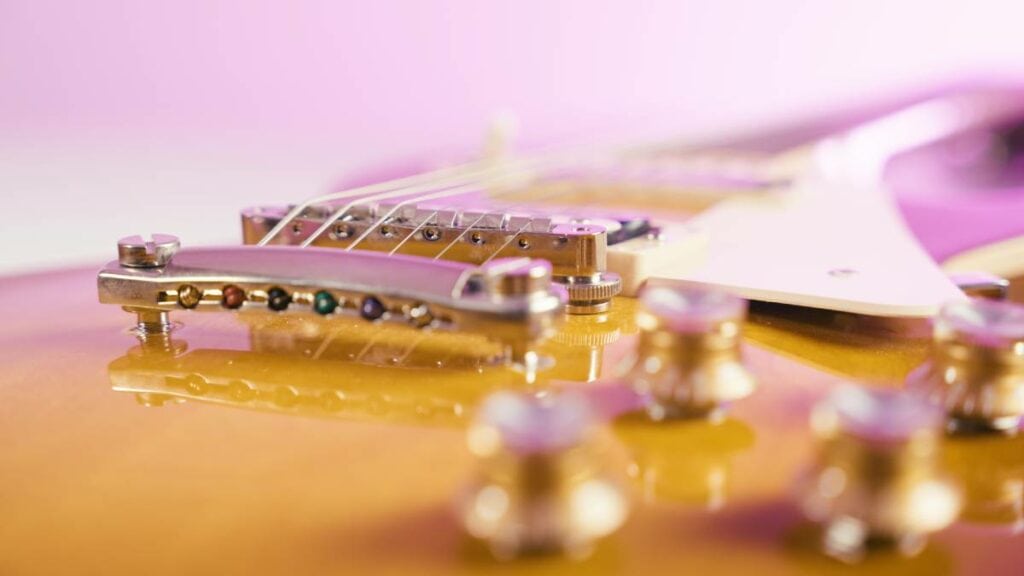
Difficulty: 5/5
Cost: 4/5
Necessity: 3/5
Like the stock tuners of a good Epiphone Les Paul, the stock bridge and tailpiece performs well too. But if you run into tuning issues and/or string breakage even with a new nut installed, you might consider upgrading your bridge and tailpiece.
The bridge and tail piece make up the second anchor point that transfers the string vibrations to the wood. They are responsible for transferring the vibrations from the string to the body, making it a critical factor in your instrument’s acoustic sound.
Upgrading your bridge and tailpiece will further make your Les Paul perform and play better, but make sure to check that the replacement bridge fits in place of your existing bridge. The risk of getting the wrong-sized parts for your guitar is what makes this one of the higher-difficulty Les Paul mods on this list.
First, you’ll want a bridge with metric posts (typically import guitars are metric, domestic guitars are imperial), then you’ll want to measure the spacing between the posts. Be sure to choose a bridge that fits those measurements or you’ll end up sending it back.
Once you have all of your measurements figured out, TonePros, Gotoh, Callaham, Wilkinson and Graph Tech have a number of Tune-o-matic bridges and tailpieces that would snug perfectly on your Epiphone Les Paul. If you want to go for something higher quality, check out one of the boutique guitar parts sellers.
Graph Tech also has graphite String Saver saddles for Les Pauls, which contribute to a bright resonant tone and are self-lubricating, saving you from breaking your strings in the future.
You can also try top-wrapping when installing your strings. From the pickup side, you insert your strings through the tailpiece and wrap them over the top. This will not only reduce string breakage by reducing the break angle, but also lessen the tension, making your strings slinkier and a lot smoother to bend. This is a technique and mod that requires zero cost. Joe Bonamassa is known to do a wraparound to make his 11s strings feel like 10.5s.
The options don’t stop there, as there are much crazier upgrades. Les Pauls are known to have a fixed bridge, but if you’re a fan of vibrato bars, the guitar world has you covered. The company, Vibramate, has a Bigsby tailor-made for a Les Paul and requires no drilling to fit. You can do this mod on your own in a matter of minutes.
Stetsbar also has their own tremolo system designed for a Les Paul and Schaller also has their “Tremolo Les Paul” which no extra holes are needed for it to fit.
Sand the Neck
Difficulty: 5/5
Cost: 1/5
Necessity: 1/5
Most Epiphone Les Pauls, just like the Gibsons they’re modelled after, have gloss finish on their necks. This is a turnoff for most players, because gloss necks tend to be sticky and can hinder your playing. You can start by sanding it with 600-grit sandpaper and moving your way up to 800 grit and finally 2000 fine grit.
While you’re sanding at 2000 grit, you can also sand the edges of the binding. This will round the sharp edges off and allow you to play smoother and worry-free.
Obviously if you’re not confident in doing this yourself, you’ll want to take it to a luthier. Of all the Les Paul mods on the list, this is the one that’s near-impossible to go back on if it goes disastrously wrong.
Replace the Frets
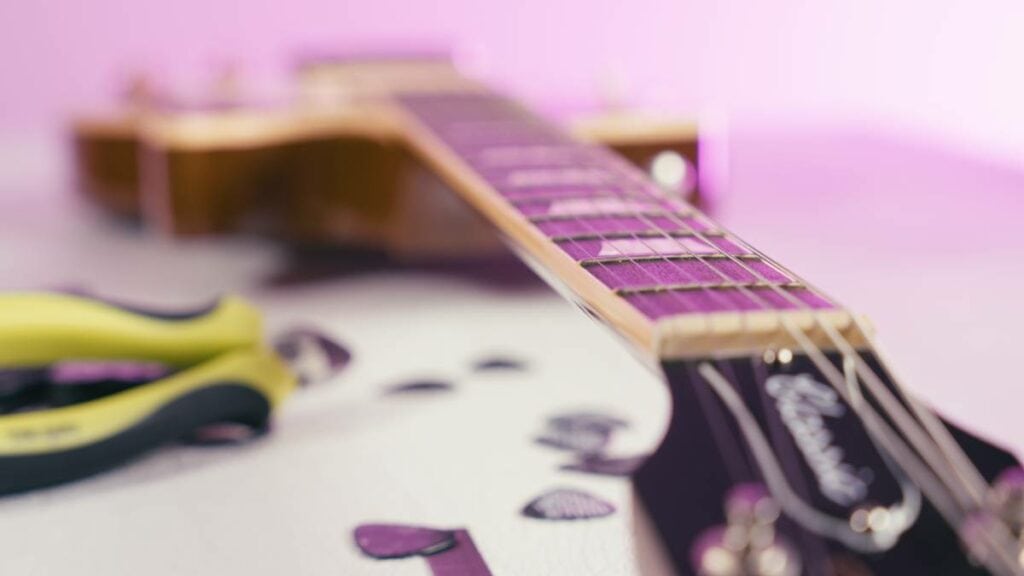
Difficulty: 5/5
Cost: 5/5
Necessity: 2/5
In due time, the frets on your Epiphone Les Paul will wear out, causing strings to choke out when bending, plus buzzing and intonation problems.
This mod may be the last thing you’ll do if you bought your Epiphone Les Paul brand new. If you bought your Les Paul second-hand and it was played significantly by the previous owner, we highly recommended this mod, which will make the guitar feel buttery and easy to play.
It is recommended that the frets be replaced along with a nut replacement and that is best done by a luthier. The luthier has all the precision tools and experience needed to install your frets perfectly along with a well-cut and fitted nut. The nut is also cut, filed, and fitted based on your preferred fret size and height.
Guitarists find medium-jumbo to jumbo frets great on a Les Paul, but if you prefer narrow and tall frets, then no one’s stopping you. Fret material depends on your personal preference. Nickel frets tend to give off a warm tone, while stainless steel has a noticeable top-end sparkle.
Stainless steel frets are much harder than nickel frets. Due to it being a harder material to work with, fitting your guitar with stainless steel frets will cost more than nickel fretwork. Modern guitar players love the feel of stainless steel frets because it is smoother to bend on them and because they’re so durable that they might outlive you. Nickel frets, on the other hand, offer the vintage feel of the original Gibsons.
Jescar is known for their high-quality frets. They offer nickel-silver alloy frets, stainless steel, and even gold frets to add bling to your guitar.
Final Thoughts on Les Paul Upgrades
When upgrading parts, make sure to keep the stock ones, which will come handy in the future.
Upgrading a guitar can be costly and time-consuming but it’s also an opportunity to explore, discover, and develop creativity. Note that not every part of your Les Paul needs an upgrade. Modifications only apply to areas that need it the most and that suit your personal preferences.
With every mod and upgrade on your guitar, it will develop into something that a bit more personal and will eventually be a reflection of your artistry. Have fun upgrading!
Related Content
- How to Spot a Fake Epiphone Les Paul
- Epiphone vs Gibson – Model Comparison
- What Strings Come ith an Epiphone Les Paul?
Main Image Credit: Roadside Guitars/Flickr. Image edited for size.

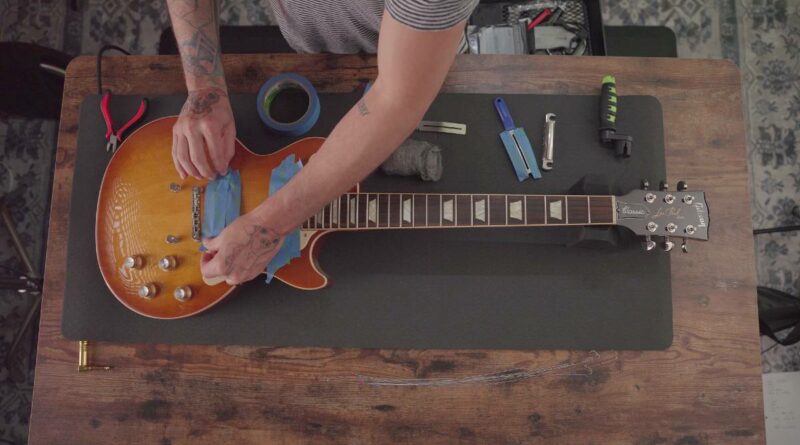
How do you feel about the dirty fingers humbucker pup made by Gibson? Is there a cheaper option without losing tone and output?
I think they’re a great pickup if you’re looking for something more modern and metal. As far as a cheaper option, my suggestion would always be to check out something like the JB – but on the used market. People are quick to knock 50% of the price off a pickup in the used market, especially when they buy a guitar and immediately replace the pickups – they’re often essentially throwing away perfectly good pickups.
Good luck!
Thank you very much for this well thought and extremely detailed article!
Keep up the good work
Cheers
I wind my own pickups. I’ve wound many sets of PAF replicas and to me, they beat any other pickup for mojo, hands down. Keep this in mind-hot pickups will not be clear and articulate. A PAF type will be well balanced and if you like a lot of gain, you will really love them because you will push the amp more and will love the tone more than using hotter pickups.
As a result of the wrap-around tailpieces of early 1950s-era Les Pauls and Les Paul Juniors, ntonation might be affected. Thankfully, replacement wrap-over bridges with changeable intonation are widely accessible. Vintage music lovers typically favour earlier all-zinc Nashville bridges over earlier ABR-1 style aluminium Tune-o-matic guitar bridges with brass saddles.